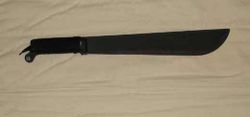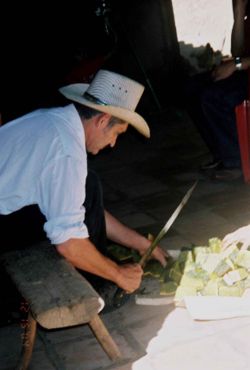From Wikipedia, the free encyclopedia

modern factory-made Machete
The machete (International Phonetic Alphabet: /məˈʃɛti/) is a cleaver-like tool that looks like a very large knife. The blade is typically 50–60 cm (18–24 in) long, usually with a thin blade under 3mm thick. In the English language, an equivalent term is matchet (though the name 'machete' enjoys greater currency).
The machete is normally used to cut through thick vegetation such as sugar cane or jungle undergrowth but it can also be used as an offensive weapon. There are many specialized designs for different regions, tasks, and budgets. In Central America it is not uncommon to see a machete being used for such household tasks as cutting large foodstuffs into pieces — much as a cleaver is used — or to perform crude cutting tasks such as making simple wooden handles for other tools.
The modern machete is very similar to some forms of the medieval falchion (a type of sword), differing mainly in the lack of a guard and a simpler hilt, though some machetes do have a guard for greater protection of hands during work.
type=text/javascript>
//<![CDATA[
if (window.showTocToggle) { var tocShowText = "show"; var tocHideText = "hide"; showTocToggle(); }
//]]>
</SCRIPT>
[edit] Cultural variations
The Swahili panga is a variant used in East Africa, with a broader blade and a squared off tip.
In Hong Kong, the machete is a widely used weapon by the Triads. It is sometimes referred to as a "watermelon knife".

Mexican Machete, from Acapulco, 1970. Horn handle, hand forged blade taper (hammer marks visible.). (Has been sharpened by owner. Rust marks visible.)

Guatemalan machete in decorated scabbard
In the Philippines, the bolo is a very similar tool, but with the blade swelling just before the tip to make the knife even more tip-heavy for chopping. A longer and a more pointed tip bolo or itak (intended for combat) was also used during the Philippine Revolution against the Spanish, and later a signature weapon of guerillas in the Philippine-American War.
Other similar tools include the parang and the golok (from Malaysia and Indonesia); however, these tend to have shorter, thicker blades with a primary grind, and are more effective on woody vegetation. The Nepalese kukri is a curved blade which is often used for similar tasks. Some types of Chinese saber (dao) are similar.
In the Southern Brazil (state of Rio Grande do Sul), the machete is largely used by the native inhabitants. It's used to open ways through the jungle, and was used to fight against the Brazilian Empire in the farrapos' war (War of Tatters 1835-1845). There, the machete is called "facão" or "facón" (literally "big knife"). Today, there is a dance called dança dos facões (machetes' dance), that is danced in this region. In this dance, performed only by men, the dancers knock their machetes while dancing, simulating a battle.
[edit] As a weapon
In many (tropical) countries, a machete is as common and ubiquitous a tool as a breadknife is in other cultures. Consequently, it is often the weapon of choice for uprisings (the poor man's sword). Machetes were the primary weapon used by the Interahamwe militias in the Rwandan Genocide, as well as the distinctive tool/weapon of the Haitian Tonton Macoute. The machete was also one of the most common weapons during the Cuban Independence War. Slaves freed by Carlos Manuel de Céspedes agreed to fight against Spain, where their only weapons were the tool they used to cut the sugar cane in the La De Majagua plantation. In 2002, a rebellion of peasants, many under the name of the Community Front in Defense of Land, in the Mexican municipality of San Salvador Atenco led the authorities to cancel a project to construct a new airport near Mexico City. In 2006, the same CFDL again took arms against the Mexican police. A machete should also be classified as a basic sword, because it can be used like one.
The Bolo Knife saw plenty of use in the jungles of the Philippines during World War II against the Japanese Imperial Army. As a result, it is a common weapon in the Filipino Martial Arts known as Kali, Arnis, or Escrima. As well as the survival knife of the military.
Some tropical countries have a name for the blow of a machete; the Spanish machetazo is sometimes used in English. In Trinidad and Tobago, to hit someone with the flat of the blade is termed planass. Although the machete is known in Trinidad and Tobago and elsewhere in the West Indies by the term 'cutlass',it is nevertheless a distinctly agricultural tool first, and a weapon of convenience second, and therefore not a true cutlass.
The Centro de Instrução de Guerra na Selva - CIGS (Instruction Center on Jungle Warfare) of Brazilian Army developed a 10-inch blade machete with a very pronounced clip point. In the same scabbard there's a 5-inch blade Bowie knife and a sharpening stone. This called "jungle kit" is made by Indústria de Material Bélico do Brasil - IMBEL(Brazilian Bellic Material Industries).
The machete is also a performance weapon used in variations the martial dance called maculele, often practiced by exponents of capoeira.
People bearing machetes affirm it is the best weapon to kill the mythical cadejo, it being light weight and flexible.
In the Friday the 13th series, horror icon Jason Voorhees uses a machete as his primary weapon.
The machete was a prominent weapon in the Rwandan Genocide, and was used against many unarmed civilians.
Toughness is important because of the twisting and impact forces that the relatively thin blade may encounter, while edge retention is secondary. Medium to high carbon spring steels such as 1050 to 1095 are well suited to this application (with better machetes using the latter), and are relatively easy to sharpen. Stainless steel machetes should be avoided, as stainless cannot stand up to repeated impacts, and will easily break even if not abused.
After hardening, the blades must be tempered to maximum toughness, often nearly spring tempered. This also makes the blade relatively harder to sharpen.

Salvadoran man cutting squash with a long knife-style machete
A properly constructed machete will have a convex or flat primary bevel from the spine to the edge, which is formed by a secondary bevel. Better machetes will also have a slight distal taper.
[edit] Manufacturing shortcuts and quality declines
Since the 1950s, most modern factory-made machetes are of very simple construction, consisting of a blade and full-length tang punched from a single piece of flat steel plate of uniform thickness (and thus lack a primary grind), and a simple grip of two plates of wood or plastic bolted or rivetted together around the tang. Finally, one side is ground down to an edge — although some are made so cheaply that the purchaser is expected to finish the sharpening. These machetes are occasionally provided with a simple cord loop as a sort of lanyard, and a canvas scabbard — although in some regions where machetes are valuable, commonly used tools, the users may make decorative leather scabbards for them.
 Free Forum Hosting
Free Forum Hosting